First experimental results of intrinsic torque on EAST
Xunyu WANG (王勛禺), Bo LYU (呂波) , Xingqiang LU (路興強(qiáng)),Yingying LI (李穎穎) , W M SOLOMON, Baolong HAO (郝保龍),Jun CHEN (陳俊),, Fudi WANG (王福地), Jia FU (符佳),Hongming ZHANG (張洪明), Jin YANG (楊進(jìn)), Bin BIN (賓斌),Liang HE (何梁), Yichao LI (李義超), Shunkuan WAN (萬順寬),Xueyu GONG (龔學(xué)余), Baonian WAN (萬寶年) and Minyou YE (葉民友)
1 School of Nuclear Science and Technology, University of South China, Hengyang 421001, People’s Republic of China
2 Institute of Plasma Physics, Chinese Academy of Sciences, Hefei 230031, People’s Republic of China
3 General Atomics, San Diego, CA, 92186-5608, United States of America
4 Department of Engineering and Applied Physics, University of Science and Technology of China, Hefei 230026, People’s Republic of China
Abstract Direct measurements of the intrinsic torque profile in L-mode plasmas on the EAST tokamak have been performed using the balanced neutral beam injection.Co-and counter-current neutral beams are modulated to balance the intrinsic and externally injected torques,which result in the rotation profile close to zero and flat. The experimental results show that the intrinsic torque derived from momentum balance equations is found to be in the co-current direction,peaked in the plasma edge and negligibly small in the core.
Keywords: intrinsic torque, balanced injection, momentum transport(Some figures may appear in colour only in the online journal)
1. Introduction
Plasma rotation is widely considered to be important in fusion plasmas for improving MHD stability [1–3] and confinement[4] by suppressing turbulence through the E×B shear. The optimal rotational profile of future fusion reactors such as ITER remains to be researched,and how to obtain the desired rotation in future devices is also an open issue. In present tokamak devices,high level of rotation is primarily driven by efficient neutral beam injection (NBI). However, for ITER and future fusion reactor plasmas, neutral beams are difficult to efficiently drive a large rotational speed due to the large plasma volume and high density.
To address this rotation driving problem,intrinsic plasma rotation [5] driven by residual stress [6], i.e. without external momentum input such as NBI, was identified and may possibly drive enough rotation in future fusion reactors.Research shows that intrinsic plasma rotation is very sensitive to magnetic field configuration, plasma density, current density profile and ion temperature [7, 8]. The experimental results of intrinsic rotation in JET [9], Alcator C-mod [5],Tore Supra [10], DIII-D [11], JT-60U [12] and EAST [13]suggest that the intrinsic rotation was strongly correlated with plasma pressure gradient or stored energy in H-mode plasma.Researches on KSTAR also shows the dependency of intrinsic rotation on plasma density and collisionality [14].Rice et al proposed that the intrinsic rotational velocity increases with the increase of plasma pressure or stored energy, and decreases with increasing plasma current, deriving a parametric scaling law of the intrinsic toroidal rotation based on observations from a large number of tokamaks[15].Extrapolation from the Rice’s scaling law indicated that the toroidal rotation velocity in the core of ITER may reach 300 km s-1, paving the way that the intrinsic rotation is a promising solution for the fusion plasma to have sufficient rotation.Rice scaling law is based on the relationship between intrinsic rotation and plasma parameters. The first indication of the residual stress in NBI discharges was observed from JFT-2M[16].The anomalous torque related to residual stress was measured directly on DIII-D [17] by balanced NBI to zero out the toroidal rotation, confirming quantitatively the presence of intrinsic torque. Subsequent research on DIIID[11,18]showed that the pressure gradient plays an important role in the intrinsic torque in the edge.
While there were a large number of studies to quantify the intrinsic torque in the tokamak plasmas, more work on various tokamaks is guaranteed in order to collect more data and reduce the uncertainty in the scaling law. In this paper,we present the experimental studies of the intrinsic torque on EAST, via recently deployed balanced neutral beams by zeroing out toroidal rotation with the delicately controlled coand counter-NBI powers and transient momentum transport analysis.
2. Experimental description
EAST is a D-shaped non-circular superconducting tokamak device(major radius R~1.85 m,minor radius a~0.45 m,the toroidal magnetic field Bt0<3.5 T,plasma current Ip<1 MA),with the capability of steady-state long-pulse advanced highperformance operation. Since 2015, EAST has been equipped with all ITER-relevant auxiliary heating and current drive systems, enabling the investigation of plasma profile control by coupling and integration of various heating and current drive power sources [19].
The NBI system of EAST consists of two sets of identical neutral beam injectors designed with tangential injection mode, whose beam energy is adjustable up to 80 keV with beam power up to 4 MW [20]. NBI1 is in the co-current direction consisting of of two ion sources, i.e.NBI1L and NBI1R tangential at different angles with NBIL slightly more tangential than the NBI1R. NBI2 is in the counter-current direction,also consisting of two ion sources,i.e. NBI2L and NBI2R with NBI2R more tangential than NBI2L. By combining the flexible injection directions of two beam lines (four sources), one can achieve balanced injection state,which will be very crucial for intrinsic torque measurement.
The toroidal rotation velocity in the experiment was measured by charge exchange recombination spectroscopy(CXRS)[21],supplemented by the X-ray crystal spectrometer[22]. The toroidal CXRS on EAST consists of core CXRS and edge CXRS, of which measurement range covers normalized radius ρ=0–1.0. Spatial resolution ranges from 10 to 30 mm from the edge to the core,and the time resolution can reach up to 10 ms, although the time resolution in the current experiments is 50 ms due to the limited signal-to-noise ratio.
3. Principle of experiments
The angular momentum balance equation describing the driving and damping of the toroidal rotation for NBI-heated plasmas can be described as follows [18]
where Vφis the toroidal rotation velocity, η is various local torque densities, χφis the angular momentum diffusivity,Vpinchis the pinch velocity of angular momentum,and ΠRSis the residual stress. If the toroidal rotation velocity is zero everywhere across the profile and not evolving, there would not be any angular momentum flux in the plasma as described in equation(1),due to the fact that all of other terms(i.e.Vφ,?Vφ/?r, ?Vφ/?t) are zero. Considering that neutral beam is injected into the plasma to achieve the aforementioned conditions,the intrinsic torque density ηintrinsiccan be extracted as shown in the following equation [17]
Similar to the method used on DIII-D, the co- and counter-NBI is applied at different power levels to modulate toroidal rotation of the EAST plasma, aiming to reduce both toroidal velocity Vφover the entire profile and toroidal velocity gradient ?Vφ/?r to nearly zero. In this manner, the diffusion and pinch term in equation (1) can be ignored.However, to measure the intrinsic torque by nulling out the plasma rotation with NBI, it is very difficult to perform experiments in a steady-state way. Nevertheless, if the rotation profile can be driven to be close to zero tentatively and the standard momentum transport term due to diffusion and pinch can be ignored transiently, the intrinsic torque density can be expressed as follows [18]

To minimize the effect of NBI and confinement on the background plasma,thus in turn affecting the intrinsic torque one tries to measure, we carefully keep the normalized beta βN=β/(Ip/aBφ) to remain stable through NBI power control, under the assumption that the residual stress does not depend on the rotation change or its shear. With this, we assume the intrinsic torque remains the same during the evolution of toroidal rotations.
4. Results and discussion
After a series of attempts,initial measurements are successfully performed on EAST for the L-mode plasmas.Two sets of NBI systems in the co-current direction and counter-current direction are used to adjust the injected torque and modulate the toroidal plasma rotation. Time evolution of the discharge parameters is shown in figure 1, in which 550 kW of LHW power has been injected throughout the discharge as the target plasmas.
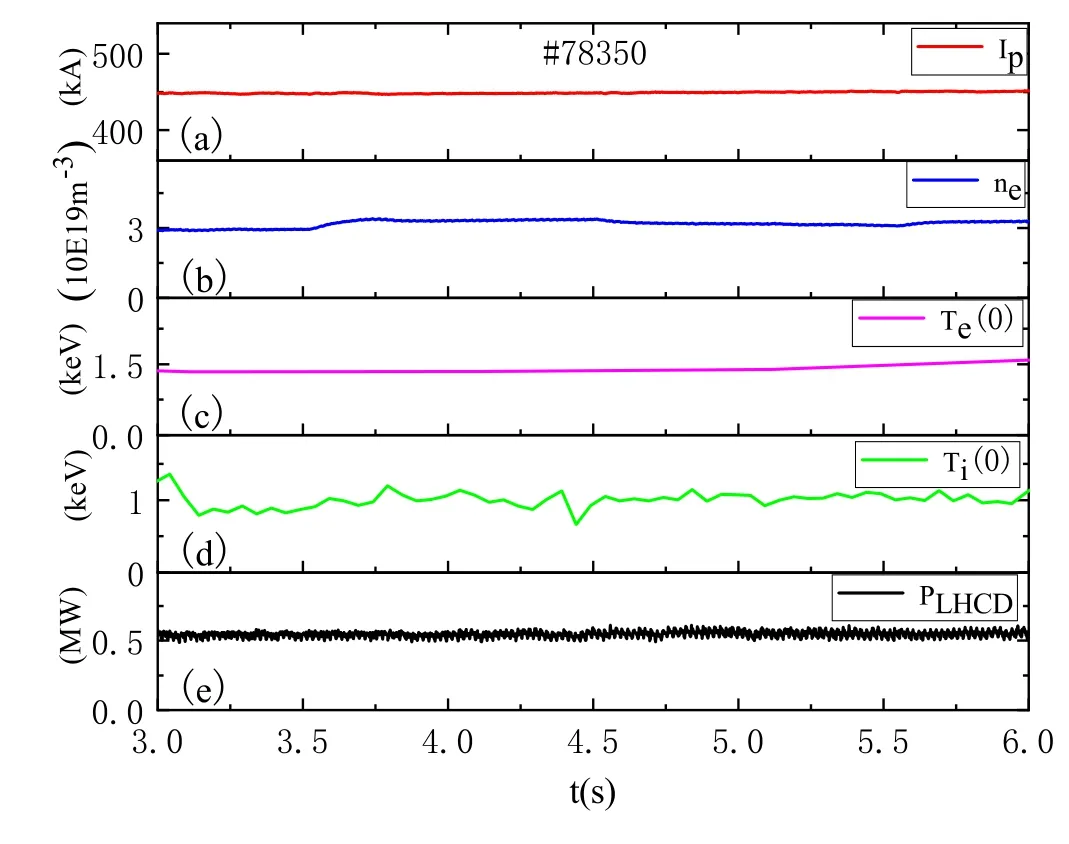
Figure 1. The time evolution of (a) plasma current, (b) averaged electron density, (c) central electron temperature, (d) central ion temperature, and (e) LHCD power.
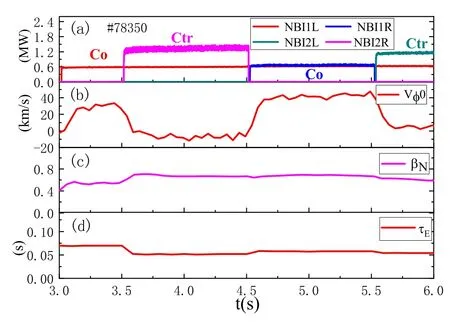
Figure 2. (a) NBI power (in MW) of co-NBI (NBI1L, NBI1R) and counter-NBI (NBI2L, NBI2R), (b) toroidal rotation velocity in core measured by charge exchange recombination spectroscopy,(c) normalized beta βN, (d) energy confinement time.
In order to make the rotational velocity zero,the modulated injection of NBI is used as shown in figure 2(a). One co-NBI(~0.6 MW)source plus one counter-NBI(~1.2 MW)source is used to balance the intrinsically driven rotation. From 3.6 to 4.5 s, the normalized beta βNis relatively stable (~0.7) as shown in figure 2(c)and the core toroidal rotation varies around zero as shown in figure 2(b). However, the βNand energy confinement time changes from ~20% at 3.5 s, when the counter-NBI is injected.In fact,it is difficult to keep βNconstant because NBI significantly increases stored energy of the plasma at low βN.Nevertheless,one can notice that the main parameters such as density, temperature and confinement remain relatively constant that are appropriate for further analysis(figure 1).The profile of these parameters and their normalized gradient shown in figures 3 and 4,do not changes substantially during the NBI,except for ion temperature in the core region.
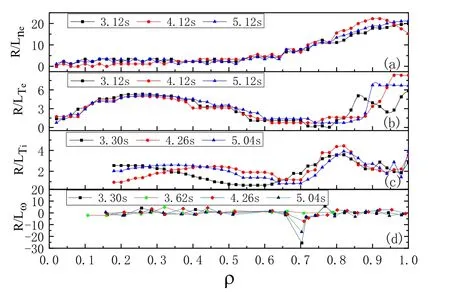
Figure 4.The normalized gradient of (a) electron density, (b)electron temperature, (c) ion temperature and (d) toroidal rotation profiles at various time slices.
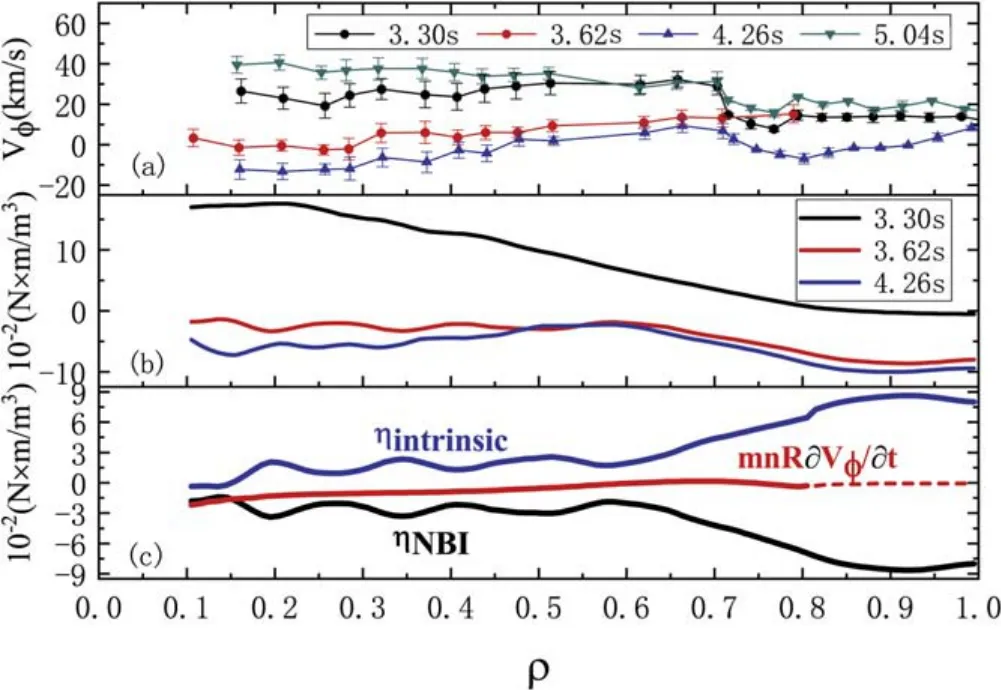
Figure 5.(a)Toroidal rotation profiles at various time slices,(b)NBI torque density at various time slices,and(c)derived intrinsic density profile.
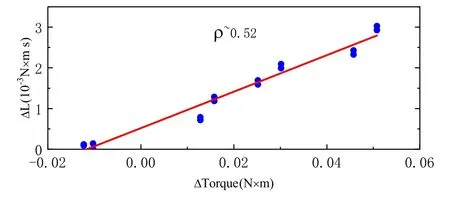
Figure 6.The plot of the angular momentum versus the NBI torque at ρ~0.52.
Figure 5 shows that the toroidal rotation is relatively close to zero across the profile at t=3.62 s and evolves around zero as the beam power modulates. With this flat and near-zero profiles, we use NUBEAM to calculate the NBI Figure 3.(a) Electron density, (b) electron temperature and (c) ion temperature profiles at various time slices.torque profile at 3.62 s.By considering the accelerating term,the intrinsic torque density is determined following equation (3) and is plotted in figure 5(c). For the first impression, one can notice that the intrinsic torque profile is in the co-current direction, relatively small in the core and peaked towards the edge, which is similar to the results as seen on DIII-D [11, 17, 18].
Neutral beam torque density profile is calculated time dependent by the NUBEAM [23, 24] software package in TRANSP. NUBEAM is a package developed by Princeton Plasma Physics Laboratory using the Monte Carlo method to evaluate physical processes such as deposition, slowingdown, and heating due to injected fast particles in tokamak plasmas. Previous studies have indicated that the simulation of the torque by NUBEAM could accurately reflect the actual torque delivered[25].In our calculations,16 000 particles are traced. Fast ion transport is also critical for neutral beam torque calculations[24].Though the classical transport of fast ions is included in the calculation of the neutral beam drive torque, the MHD activities can enhance this transport,including fishbone activities [26], neoclassical tearing modes[27]and Alfvén eigenmodes[28].Obviously,the presence of these modes may change the torque delivered by the neutral beams,causing additional uncertainty in the calculated torque profile.At relatively low NBI energy and power,the analysis presented so far does not consider these effects on torque calculation,which are considered to be small since there is no noticeable strong MHD activities in the current experiments.
In fact, the measured rotational profile is not zero everywhere,although the toroidal rotation across the profile is very small.The intrinsic torque can be alternatively estimated by comparing the relationship between the deposited neutral beam torque and the angular momentum within each radius.The angular momentum can be plotted against the neutral beam torque within each radius, such as in figure 6.The data shows a fairly linear correlation at all radii.Therefore,for this series of experiments, the neutral beam torque corresponding to zero angular momentum can always be found, which provides a good approximation for the intrinsic torque [17].Then,the estimated intrinsic torque Testimateis used to find the profile of the intrinsic torque density ηestimate.In this manner,the intrinsic torque density profile can be further estimated as shown in figure 7, which indicates that the small residual rotation is not high enough to dramatically alter the shape and magnitude of the intrinsic torque profile.

Figure 7.(a)The estimated intrinsic torque profile determined by the function of the neutral beam torque and the angular momentum at each radius (red line) and the intrinsic torque profile determined by the negative of the neutral beam when the toroidal rotation is close to zero across the profile (green line). (b) Inverted intrinsic torque density profile.
The shape of intrinsic torque profile measured on EAST is very similar to the intrinsic torque profile on DIII-D[11,17,18].The intrinsic torque profiles of these two devices are both in the co-current direction, peaked towards the edge and relatively small in the core, although with an order of magnitude different due to vast difference in operation parameters. Studies on DIII-D indicated that the edge intrinsic torque (obtained by volume integrating the inferred intrinsic torque density profile) is strongly correlated with the edge pressure gradient, which is also true for EAST’s results. The driving of intrinsic torque has been proposed to be from residual stress and validated for the rotation profile change due to residual stress induced torque, i.e. intrinsic torque driven by residual stress[29].Intrinsic torque is also strongly dependent on normalized gyroradius and collissonality,which has been investigated to derive correlations for predicting possible intrinsic torques on future fusion reactors and validating the theoretical models[30].Experiments on EAST are expected to extend towards larger parameter range,especially for H-mode plasmas with edge transport barriers.
5. Summary
The co- and counter-NBI are used to balance the toroidal rotation, driving the toroidal rotation to be relatively close to zero across the entire profile,and the intrinsic torque profile is measured using transient momentum balance analysis on EAST. During the experiment, the effort is dedicated to minimize the influence of neutral beam on the background plasma, thus to keep the intrinsic torque as constant as possible. Moreover, we further validate the results using the linear relationship between NBI torque and angular momentum. Although the analysis has not taken into account the effect of fast ions, the intrinsic torque profile is finally obtained, which is very similar to the intrinsic torque profile obtained on DIII-D. The intrinsic torque is in the co-current direction, relatively small in the core and peaked towards the edge.
Acknowledgments
This work is supported by the National Key Research and Development Program of China(Nos.2017YFE0301300 and 2017YFE0302000), Key Program of Research and Development of Hefei Science Center, CAS (No. 2017HSCKPRD002), Distinguished Young Scholar of Anhui Provincial Natural Science Foundation (1908085J01), the Key Projects of Hunan Provincial Department of Education(18A238), the Key Laboratory of Magnetic Confinement Nuclear Fusion Research in Hengyang (2018KJ108).
ORCID iDs
Bo LYU (呂波) https://orcid.org/0000-0002-3916-6230 Yingying LI (李穎穎) https://orcid.org/0000-0002-2978-908X
 Plasma Science and Technology2020年6期
Plasma Science and Technology2020年6期
- Plasma Science and Technology的其它文章
- First-principles study on the mechanical properties and thermodynamic properties of Mo–Ta alloys
- Formation mechanism of Al2O3/MoS2 nanocomposite coating by plasma electrolytic oxidation (PEO)
- Estimation of the sheath power dissipation induced by ion cyclotron resonance heating
- Influence of toroidal rotation on the tearing mode in tokamak plasmas
- Conversion between Vickers hardness and nanohardness by correcting projected area with sink-in and pile-up effects
- In-port-plug transmission line design of the ITER plasma position reflectometer
